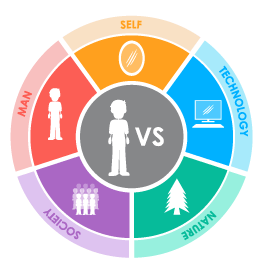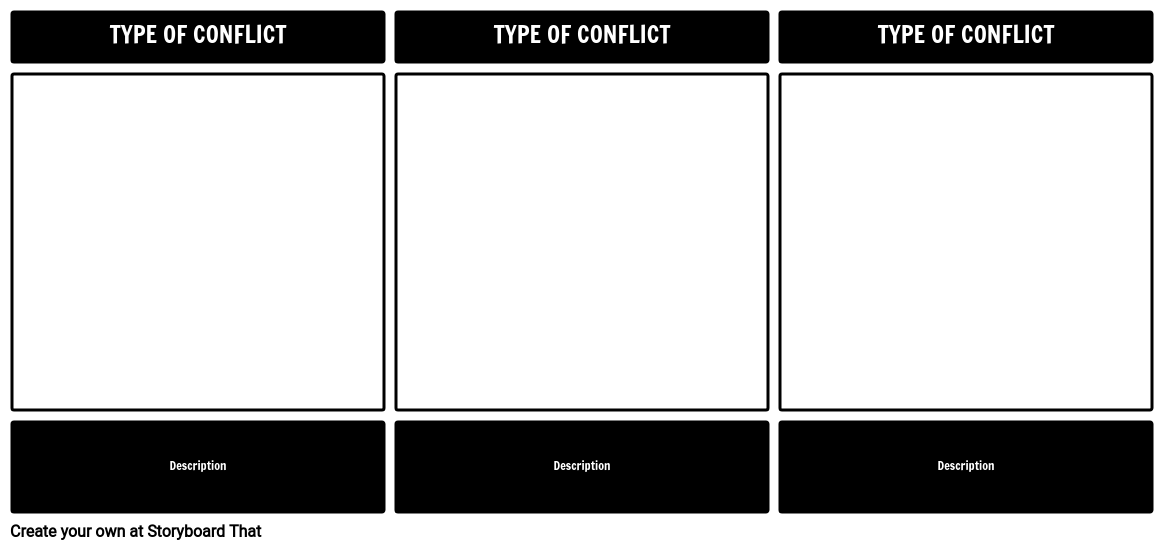Lesson Plan Overview
Storyboarding is an excellent way to focus on types of literary conflicts.
Having students create storyboards that show the cause and effect of different types of conflicts strengthens analytical thinking about literary concepts. Have your students choose an example of each literary conflict and depict them using the storyboard creator. In the storyboard, an example of each conflict should be visually represented, along with an explanation of the scene, and how it fits the particular category of conflict.
Examples of Literary Conflict in “The Black Cat”
MAN vs. SELF
The narrator is battling alcoholism, which also sends him into rages of violence against his pets and his wife. After he gouges Pluto’s eye, he is wracked with guilt, which eventually turns to anger, leading him to hang Pluto. The guilt continues as he is unable to accept the affections of the second eyeless cat, and his anger continues to be an obstacle he cannot overcome.
MAN vs. NATURE
The narrator is so confused, guilt-ridden, and miserable that he comes to see the cats as his enemies. The second cat does eventually get the better of the narrator, however, by revealing the murder of his wife, and finally bringing justice to the narrator’s evil deeds.
MAN vs. MAN
The narrator regularly takes out his anger and drunken violence on his wife, but when she tries to stop him from killing the black and white cat, she crosses a line that he will not stand for. In a rage, he kills her for stopping him from putting an end to his misery with the cat.
Template and Class Instructions
(These instructions are completely customizable. After clicking "Copy Activity", update the instructions on the Edit Tab of the assignment.)
Student Instructions
Create a storyboard that shows at least three forms of literary conflict in “The Black Cat”.
- Identify conflicts in “The Black Cat”.
- Categorize each conflict as Character vs. Character, Character vs. Self, Character vs. Society, Character vs. Nature, or Character vs. Technology.
- Illustrate conflicts in the cells, using characters from the story.
- Write a short description of the conflict below the cell.
Lesson Plan Reference
Student Rubric
(You can also create your own on Quick Rubric.)
| Proficient | Emerging | Beginning | Try Again | |
|---|---|---|---|---|
| Conflict Identification | Student identifies correct major conflicts and uses strong, clear textual evidence to support choice. | Student identifies correct major conflict and uses few or unclear details to support their choice. | Student identifies incorrect major conflict, and uses some details from the text to support their choice. | Student does not attempt to identify major conflict or identifies incorrect major conflict with no explanation. |
| Understanding Outcome | Student clearly shows the outcome of the conflict and its effects on the protagonist with evidence from the text. | Student shows the outcome of the conflict and its effect on the protagonist, but some evidence is unclear. | Student shows the outcome of the conflict, but does not examine its effect on the protagonist and uses some vague textual evidence. | Student does not clearly show the outcome of the conflict or use textual evidence. |
| Character | Storyboard includes all required characters and clearly names them. Goes above and beyond by adding additional details. | Storyboard includes all required characters and clearly names them. | Storyboard includes protagonist and antagonist but leaves out other required characters. | Storyboard does not include the names of required characters. |
| Storyboard | Student clearly shows effort to convey the setting the scene of the book | Student attempts to convey setting and scene of the book, but lacks some clarity. | Student does not clearly convey the setting and scene. | Student makes little or no attempt to convey the setting or scene. |
| Spelling and Grammar | Student uses exemplary spelling and grammar. There are no errors. | Student makes a minor error in spelling and grammar. | Student makes several minor errors in spelling and grammar. | Student makes many errors in spelling and grammar; little attempt at spellchecking. |
Lesson Plan Overview
Storyboarding is an excellent way to focus on types of literary conflicts.
Having students create storyboards that show the cause and effect of different types of conflicts strengthens analytical thinking about literary concepts. Have your students choose an example of each literary conflict and depict them using the storyboard creator. In the storyboard, an example of each conflict should be visually represented, along with an explanation of the scene, and how it fits the particular category of conflict.
Examples of Literary Conflict in “The Black Cat”
MAN vs. SELF
The narrator is battling alcoholism, which also sends him into rages of violence against his pets and his wife. After he gouges Pluto’s eye, he is wracked with guilt, which eventually turns to anger, leading him to hang Pluto. The guilt continues as he is unable to accept the affections of the second eyeless cat, and his anger continues to be an obstacle he cannot overcome.
MAN vs. NATURE
The narrator is so confused, guilt-ridden, and miserable that he comes to see the cats as his enemies. The second cat does eventually get the better of the narrator, however, by revealing the murder of his wife, and finally bringing justice to the narrator’s evil deeds.
MAN vs. MAN
The narrator regularly takes out his anger and drunken violence on his wife, but when she tries to stop him from killing the black and white cat, she crosses a line that he will not stand for. In a rage, he kills her for stopping him from putting an end to his misery with the cat.
Template and Class Instructions
(These instructions are completely customizable. After clicking "Copy Activity", update the instructions on the Edit Tab of the assignment.)
Student Instructions
Create a storyboard that shows at least three forms of literary conflict in “The Black Cat”.
- Identify conflicts in “The Black Cat”.
- Categorize each conflict as Character vs. Character, Character vs. Self, Character vs. Society, Character vs. Nature, or Character vs. Technology.
- Illustrate conflicts in the cells, using characters from the story.
- Write a short description of the conflict below the cell.
Lesson Plan Reference
Student Rubric
(You can also create your own on Quick Rubric.)
| Proficient | Emerging | Beginning | Try Again | |
|---|---|---|---|---|
| Conflict Identification | Student identifies correct major conflicts and uses strong, clear textual evidence to support choice. | Student identifies correct major conflict and uses few or unclear details to support their choice. | Student identifies incorrect major conflict, and uses some details from the text to support their choice. | Student does not attempt to identify major conflict or identifies incorrect major conflict with no explanation. |
| Understanding Outcome | Student clearly shows the outcome of the conflict and its effects on the protagonist with evidence from the text. | Student shows the outcome of the conflict and its effect on the protagonist, but some evidence is unclear. | Student shows the outcome of the conflict, but does not examine its effect on the protagonist and uses some vague textual evidence. | Student does not clearly show the outcome of the conflict or use textual evidence. |
| Character | Storyboard includes all required characters and clearly names them. Goes above and beyond by adding additional details. | Storyboard includes all required characters and clearly names them. | Storyboard includes protagonist and antagonist but leaves out other required characters. | Storyboard does not include the names of required characters. |
| Storyboard | Student clearly shows effort to convey the setting the scene of the book | Student attempts to convey setting and scene of the book, but lacks some clarity. | Student does not clearly convey the setting and scene. | Student makes little or no attempt to convey the setting or scene. |
| Spelling and Grammar | Student uses exemplary spelling and grammar. There are no errors. | Student makes a minor error in spelling and grammar. | Student makes several minor errors in spelling and grammar. | Student makes many errors in spelling and grammar; little attempt at spellchecking. |
How Tos about Literary Conflict in “The Black Cat”
How to facilitate a class discussion on literary conflict in 'The Black Cat'
Engage your class by starting with a quick review of the different types of conflict. Ask students to share examples from other stories or real life to activate prior knowledge and build connections.
Guide students in identifying conflict types together
Read key passages aloud and pause to let students point out where a conflict occurs. Encourage students to justify their choices and categorize the conflict as Character vs. Self, Character vs. Nature, or Character vs. Character.
Encourage students to support their answers with evidence
Ask students to cite specific lines or actions from the text that show the conflict. This helps students practice finding and using textual evidence to back up their analysis.
Foster peer-to-peer discussion and respectful debate
Invite students to respond to each other's ideas and share alternative interpretations. Model respectful disagreement to create a safe space for critical thinking and open dialogue.
Wrap up with a reflective prompt
Have students reflect on how conflicts drive the story and connect to larger themes. Ask them to consider how recognizing conflict can deepen their understanding of both this story and others they read.
Frequently Asked Questions about Literary Conflict in “The Black Cat”
What are the main types of literary conflict in 'The Black Cat'?
The main types of literary conflict in 'The Black Cat' are Man vs. Self (the narrator's struggle with guilt and alcoholism), Man vs. Nature (the narrator's battle with the cats), and Man vs. Man (the violent conflict between the narrator and his wife).
How can I teach literary conflict using storyboards for 'The Black Cat'?
To teach literary conflict with storyboards, have students choose examples of each conflict type from 'The Black Cat', illustrate them in storyboard panels, and write brief explanations describing how each scene fits its conflict category.
What is an example of Man vs. Self conflict in 'The Black Cat'?
An example of Man vs. Self conflict is the narrator battling his own guilt and alcoholism, which leads him to harm his pets and his wife, and ultimately struggle with remorse and anger.
Why is teaching conflict important in high school literature lessons?
Teaching conflict helps students analyze characters' motivations, understand story structure, and build critical thinking skills by identifying how struggles drive plot and character development.
What are effective ways to help students identify literary conflicts in stories?
Effective ways include using visual tools like storyboards, having students categorize conflicts (e.g., Character vs. Self, Nature, or Another Character), and prompting them to explain and illustrate each conflict's impact on the story.
More Storyboard That Activities
Black Cat, The
Testimonials

“By using the product, they were so excited and they learned so much...”–K-5 Librarian and Instructinal Technology Teacher

“I'm doing a Napoleon timeline and I'm having [students] determine whether or not Napoleon was a good guy or a bad guy or somewhere in between.”–History and Special Ed Teacher

“Students get to be creative with Storyboard That and there's so many visuals for them to pick from... It makes it really accessible for all students in the class.”–Third Grade Teacher
© 2026 - Clever Prototypes, LLC - All rights reserved.
StoryboardThat is a trademark of Clever Prototypes, LLC, and Registered in U.S. Patent and Trademark Office








